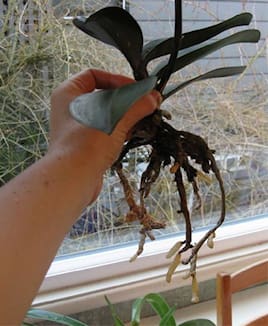OK, so you’ve finally found the right potting medium that works great to keep your plants growing and blooming, and you know you really should repot, but every time you do, the plants are set back and skip a year of blooming, or maybe just die. This article will explain a bit about the importance of repotting, and why and how you should do so.
Why should we repot our plants?
As most of our cultivated orchids are epiphytes, the potting medium provides little-to-no inherent nutritional value, but is intended for mechanical stability and to hold water and nutrients we apply. But all potting media change over time, and that’s the reason we must repot periodically. There are many different ways media can change that may be detrimental to the plants, but the most significant two are becoming too compact and the accumulation of minerals and biofilm.
Let’s talk roots.
Unlike terrestrial plants that do much of their gas exchange processes through their leaves (losing 95% or more of their absorbed water in the process), orchids have evolved a water-retention strategy by doing most of their gas exchange through their roots. Additionally, as plants’ roots grow, they “tailor” the cell structure so that they will function optimally in that environment. Once they have grown, they cannot change.
It is that last couple of sentences that are most important. If the plant has grown roots in a really good potting medium, it will perform well. If that potting medium changes however, all those “optimized” roots will not function as well, and may begin to fail.
Changes in Potting Media
As potting media age, they decompose and become more and more compact. A compact medium has smaller void spaces which can hold more water, cutting off the air flow and suffocating the roots. With age, all media accumulate minerals and biofilm, also referred-to as “bacterial sludge”, and both can be toxic in extreme cases.
Moreover, if the potting medium has changed, the newest roots – those grown recently in that “less than ideal mix” will have grown optimized for those conditions, so will do poorly once repotted into fresh mix. (Note the new, white root growth on the ends of “sad” roots on this plant that wasn’t repotted often enough…)

So how do we deal with such an apparent dilemma?
The “ideal” potting and repotting strategy.
Repot more often. It’s really as simple as that. Think about it. If you repot before the medium has had a chance to significantly change, there will be no chance for compacting and suffocation, not enough minerals will be accumulated nor will significant biofilm growth take place, but best of all – the “old” and “new” root environments will be nearly identical, so with care not to damage them in the process, repotting maintains the “optimal” status of the roots and there will be no setback.
Steve Male, who operates Fishing Creek Orchids in Harrisburg PA, is one of the best growers I’ve ever met. He has a strict regimen that involves repotting everything annually, leading to spectacular growth that has led to a stack of awards.
Some may feel it is an excessive expense to do that, but if you think about the cost of some plants, it seems that a small, additional maintenance cost is preferred to dealing with setbacks, dealing with diseases, and the cost of replacement plants.